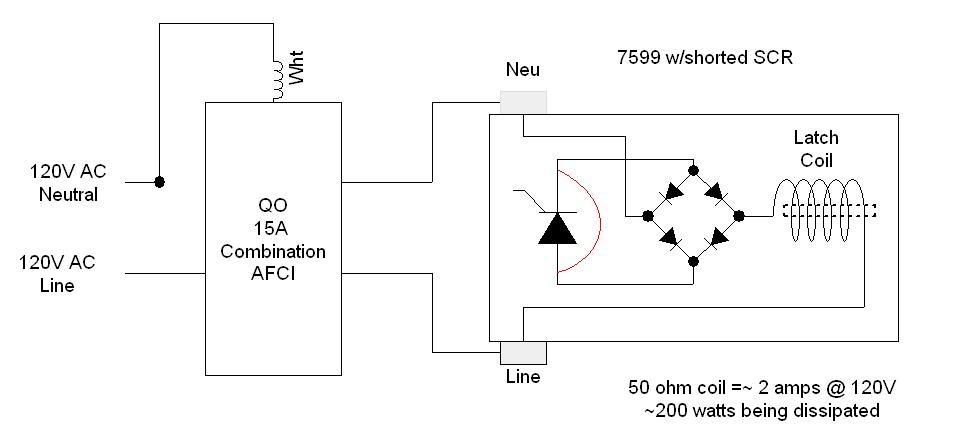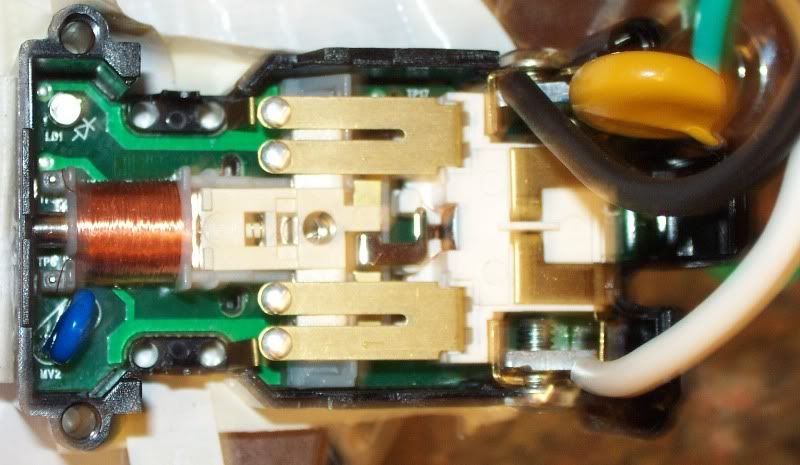ELA
Senior Member
- Occupation
- Electrical Test Engineer
This tread was inspired by a previous thread where GFCI failure modes were discussed and another where an appliance caught fire and it was wondered why the standard upstream breaker did not trip.
In one thread ?Tool_5150? mentioned he found a Leviton GFCI with a coil blown apart. ?Gar? theorized that it might have been a shorted bridge diode or SCR.
In order to show the effects of a failed SCR on the Leviton unit I wanted to test this failure mode. Having previously been inspired by Gar to disassemble a unit.
In the other thread it was questioned how an appliance could catch fire without the breaker upstream having tripped. In that thread it was mentioned ?that was what AFCIs were for?. And a question, would a AFCI have prevented this?
I have been interested in working with AFCIs since I am not normally exposed to them.
I decided to combine the two devices into one experiment. I wanted to test the effects of a shorted SCR in the GFCI. Knowing that as the coil heated that it could possibly provide a lower impedance at some point in its failure I wanted some additional protection upstream. For this I used an AFCI.
Below is diagram of the test setup.

Here are two pictures of the GFCI coil one prior to the test and one after.


It only took about 3 seconds after the application of 120V for smoke to start to appear and the coil burst into a small flame as the coating on the wire burnt. The flame only lasted a few seconds and died out.
From this test it is apparent that a shorted SCR can indeed cause severe damage to the coil and that it will happen within seconds.
I also found it interesting that a small flame appeared and the AFCI did not trip.
Please note that the coil was exposed (unlike in normal operation) and from what I saw it would be unlikely to actually start a house fire in a normal installation.
But still interesting. The series arc created as the coil burning open must never have exceeded 5 amps? From the looks of the coil it did not fail severely enough to cause any low impedance parallel arcing.
I took crude video and will post that shortly if I can.
In one thread ?Tool_5150? mentioned he found a Leviton GFCI with a coil blown apart. ?Gar? theorized that it might have been a shorted bridge diode or SCR.
In order to show the effects of a failed SCR on the Leviton unit I wanted to test this failure mode. Having previously been inspired by Gar to disassemble a unit.
In the other thread it was questioned how an appliance could catch fire without the breaker upstream having tripped. In that thread it was mentioned ?that was what AFCIs were for?. And a question, would a AFCI have prevented this?
I have been interested in working with AFCIs since I am not normally exposed to them.
I decided to combine the two devices into one experiment. I wanted to test the effects of a shorted SCR in the GFCI. Knowing that as the coil heated that it could possibly provide a lower impedance at some point in its failure I wanted some additional protection upstream. For this I used an AFCI.
Below is diagram of the test setup.

Here are two pictures of the GFCI coil one prior to the test and one after.


It only took about 3 seconds after the application of 120V for smoke to start to appear and the coil burst into a small flame as the coating on the wire burnt. The flame only lasted a few seconds and died out.
From this test it is apparent that a shorted SCR can indeed cause severe damage to the coil and that it will happen within seconds.
I also found it interesting that a small flame appeared and the AFCI did not trip.
Please note that the coil was exposed (unlike in normal operation) and from what I saw it would be unlikely to actually start a house fire in a normal installation.
But still interesting. The series arc created as the coil burning open must never have exceeded 5 amps? From the looks of the coil it did not fail severely enough to cause any low impedance parallel arcing.
I took crude video and will post that shortly if I can.
